木星 月惑星研究会 関西支部

Jupiter Image 2006/06/22(UT)
Guilherme Grassmann,Ralf Vandebergh,Christophe Pellier,Daniel Chang,Riccardo Di Nasso
G.Grassmann,R.Vandebergh,Christophe.P,D.Chang,Riccardo
|
Guilherme Grassmann (250mm SCT Meade: Toucam Pro) |
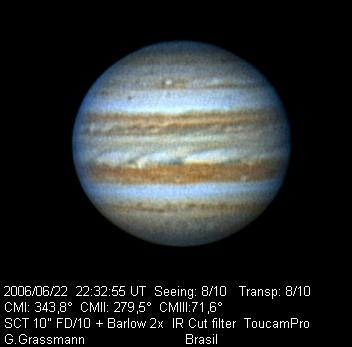 [Guilherme Grassmann,Americana-San Paulo,Brasil]
[Guilherme Grassmann,Americana-San Paulo,Brasil]
|
Ralf Vandebergh(250mm Newton:ATK-1HS) |
This is an image obtained on June 22 with the area of the 2 NEBn white ovals.
Seeing was fair for the altitude of 22 degr.
10 inch Newtonian & ATK-1HS,IR670-1000nm,Blue)
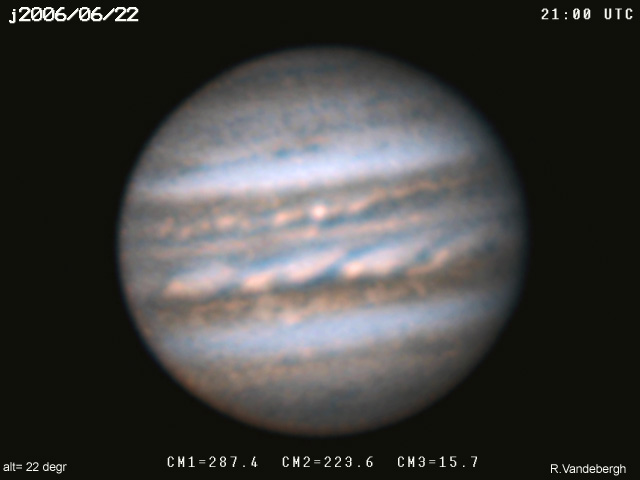 Here is a special monochrome part showing the region WS-Z.The shape of the 2 white ovals
is better visible in this bw version.
Here is a special monochrome part showing the region WS-Z.The shape of the 2 white ovals
is better visible in this bw version.
 Beside the 2 NEBn ovals there is also an exceptionally bright spot
in the SEB,here approximately at the CM.This spot was especially in the blue light images obvious.
seeing: fair considering the altitude(22 degr).
Beside the 2 NEBn ovals there is also an exceptionally bright spot
in the SEB,here approximately at the CM.This spot was especially in the blue light images obvious.
seeing: fair considering the altitude(22 degr).
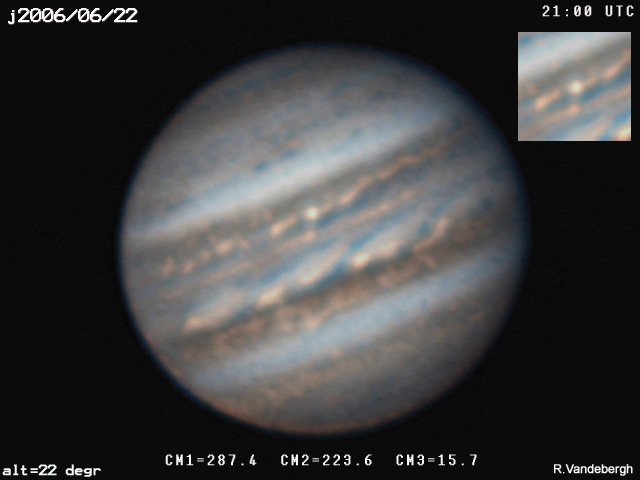 The attached false color image from June 22,shows brightness differences between WS and Z.
(IR-B image conv.to monochrome)
The attached false color image from June 22,shows brightness differences between WS and Z.
(IR-B image conv.to monochrome)
 I have made a comparison of June 17 and June 22 images in IR and blue light.
It shows the following interesting things:
-difference of shift of the WSZ-WSY area.(see also animation)
-difference of brightening of the bright SEB-spot.I have named this on my images 'Br'.
Clearly is visible that the spot wasn't obvious bright in the June 17 images.So it really
seemed to brighten up in the short-wavelength images especially.
further:- the difference of brightness between WSZ and WSY in the June 22 blue images
compared to the June 17 images,shows that there must indeed have something happened
in color between both ovals.On June 17,there wasn't any big brightness difference yet.
I have made a comparison of June 17 and June 22 images in IR and blue light.
It shows the following interesting things:
-difference of shift of the WSZ-WSY area.(see also animation)
-difference of brightening of the bright SEB-spot.I have named this on my images 'Br'.
Clearly is visible that the spot wasn't obvious bright in the June 17 images.So it really
seemed to brighten up in the short-wavelength images especially.
further:- the difference of brightness between WSZ and WSY in the June 22 blue images
compared to the June 17 images,shows that there must indeed have something happened
in color between both ovals.On June 17,there wasn't any big brightness difference yet.

 The albedo of this SEB spot is comparable(or even more) with the brightness
of the 'notorious 'bright spaces
between the festoons in the EZ,often burnt out in amateur-images.
This negative image shows that.
A good night but with 30 mn of clouds that prevented me from
taking better images of the WSZ area
http://www.astrosurf.org/pellier/J060622-CPE
As said in my preliminary post,there migth be a northern shift of WSZ
with WSY. The two spots look to be 6-7° apart.
Same comentary than Ralf about the bright spot on the SEB - it's
impressive in the short wavelenghts,certainly the brightest cloud of
the planet in blue or violet ! Maybe this is a new outbreak ? This is
when one regrets not having a CH4 filter...
A final note on the technical side ; I think that I've finally been able
with this session to identify albedo differences between the Blue filter
and the SP470. Jupiter in that last one looks globally less contrasted
(especially belts are less dark),and the albedo of the EB looks closer
to that of the SEB than in blue light,where the SEB is certainly
darker. The SP470 is transparent in UV (peaks at 380 nm +/- 150 nm) (but
not the Astronomik B (440 nm +/- 120 nm),and therefore could be
sensitive to higher scattering hazes,those ones better seen in full UV.
Best wishes
Christophe
PS for Paolo : my e-mails are not joining you at all now...
The albedo of this SEB spot is comparable(or even more) with the brightness
of the 'notorious 'bright spaces
between the festoons in the EZ,often burnt out in amateur-images.
This negative image shows that.
A good night but with 30 mn of clouds that prevented me from
taking better images of the WSZ area
http://www.astrosurf.org/pellier/J060622-CPE
As said in my preliminary post,there migth be a northern shift of WSZ
with WSY. The two spots look to be 6-7° apart.
Same comentary than Ralf about the bright spot on the SEB - it's
impressive in the short wavelenghts,certainly the brightest cloud of
the planet in blue or violet ! Maybe this is a new outbreak ? This is
when one regrets not having a CH4 filter...
A final note on the technical side ; I think that I've finally been able
with this session to identify albedo differences between the Blue filter
and the SP470. Jupiter in that last one looks globally less contrasted
(especially belts are less dark),and the albedo of the EB looks closer
to that of the SEB than in blue light,where the SEB is certainly
darker. The SP470 is transparent in UV (peaks at 380 nm +/- 150 nm) (but
not the Astronomik B (440 nm +/- 120 nm),and therefore could be
sensitive to higher scattering hazes,those ones better seen in full UV.
Best wishes
Christophe
PS for Paolo : my e-mails are not joining you at all now...
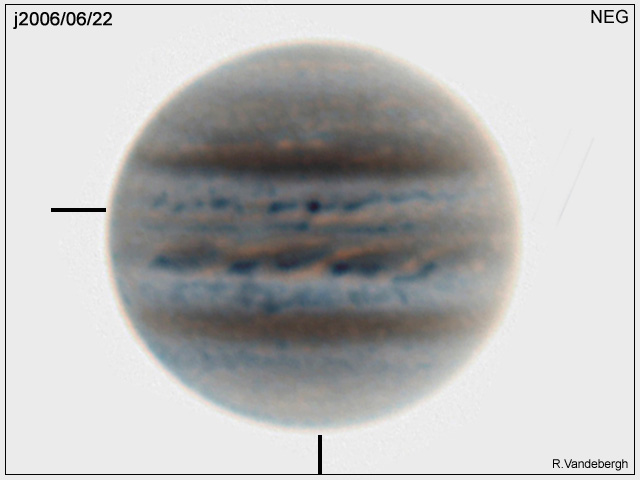 The bright SEB-spot as mentioned in previous messages is probably the
brightest detail on Jupiter now.
I made this threshold-value movie,which demonstrates that.
The bright SEB-spot as mentioned in previous messages is probably the
brightest detail on Jupiter now.
I made this threshold-value movie,which demonstrates that.
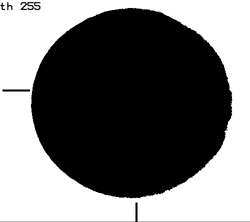 I've found a possible explanation for the bright SEB spot,recorded in
images on June 22.
As the animation shows,2 normal SEB spots,still separated on June 17,seemed
to merge into the bright one on June 22.
The animation shows also the shift of the WSZ-WSY-system on June 17 and 22.
Possibly this spot had very short live.The latest images from Japan suggest
no great activity.
I've found a possible explanation for the bright SEB spot,recorded in
images on June 22.
As the animation shows,2 normal SEB spots,still separated on June 17,seemed
to merge into the bright one on June 22.
The animation shows also the shift of the WSZ-WSY-system on June 17 and 22.
Possibly this spot had very short live.The latest images from Japan suggest
no great activity.

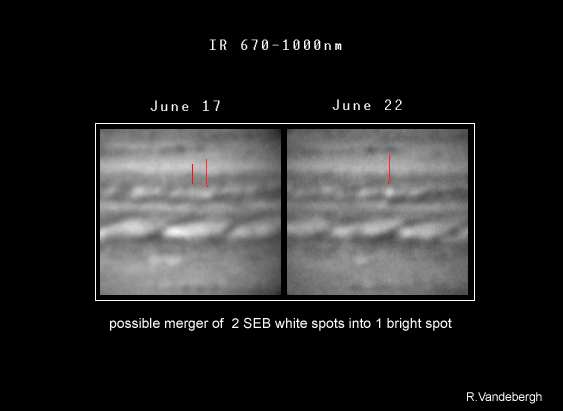 [バンディバ:オランダ]
[Ralf Vandebergh:Neighbourhood of Maastricht Netherlands]
[バンディバ:オランダ]
[Ralf Vandebergh:Neighbourhood of Maastricht Netherlands]
|
Christophe Pellier (C14 ; L075M) |
Hi all,a good night but with 30 mn of clouds that prevented me from taking better images of the WSZ area
As said in my preliminary post,there migth be a northern shift of WSZ with WSY. The two spots look to be 6-7° apart.
Same comentary than Ralf about the bright spot on the SEB - it's impressive in the short wavelenghts,certainly the brightest cloud of the planet in blue or violet ! Maybe this is a new outbreak ? This is when one regrets not having a CH4 filter...
A final note on the technical side ; I think that I've finally been able with this session to identify albedo differences between the Blue filter and the SP470. Jupiter in that last one looks globally less contrasted (especially belts are less dark),and the albedo of the EB looks closer to that of the SEB than in blue light,where the SEB is certainly darker. The SP470 is transparent in UV (peaks at 380 nm +/- 150 nm) (but not the Astronomik B (440 nm +/- 120 nm),and therefore could be sensitive to higher scattering hazes,those ones better seen in full UV.
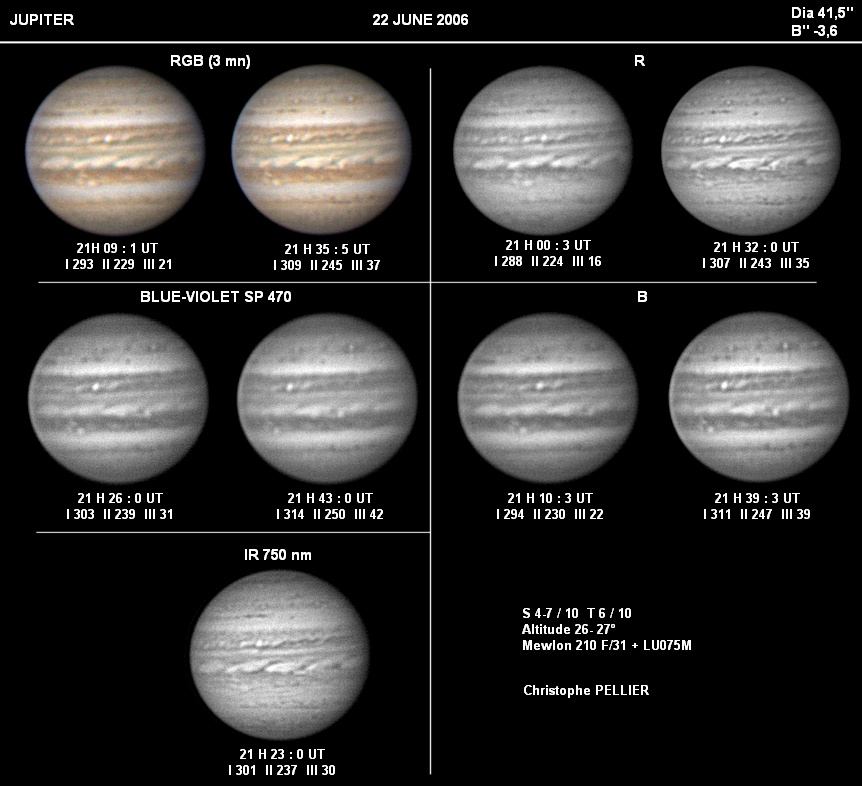
[Christophe Pellier Bruz City,France]
|
Daniel Chang (254mm SCT Philips ToUcam Pro) |

[Daniel Chang : Hong Kong]
|
Riccardo Di Nasso ( Celestron C8 200mm SC ) |
 [Riccardo Di Nasso,Italy]
[Riccardo Di Nasso,Italy]


[Guilherme Grassmann,Americana-San Paulo,Brasil]
Here is a special monochrome part showing the region WS-Z.The shape of the 2 white ovals is better visible in this bw version.
Beside the 2 NEBn ovals there is also an exceptionally bright spot in the SEB,here approximately at the CM.This spot was especially in the blue light images obvious. seeing: fair considering the altitude(22 degr).
The attached false color image from June 22,shows brightness differences between WS and Z. (IR-B image conv.to monochrome)
I have made a comparison of June 17 and June 22 images in IR and blue light. It shows the following interesting things: -difference of shift of the WSZ-WSY area.(see also animation) -difference of brightening of the bright SEB-spot.I have named this on my images 'Br'. Clearly is visible that the spot wasn't obvious bright in the June 17 images.So it really seemed to brighten up in the short-wavelength images especially. further:- the difference of brightness between WSZ and WSY in the June 22 blue images compared to the June 17 images,shows that there must indeed have something happened in color between both ovals.On June 17,there wasn't any big brightness difference yet.

The albedo of this SEB spot is comparable(or even more) with the brightness of the 'notorious 'bright spaces between the festoons in the EZ,often burnt out in amateur-images. This negative image shows that. A good night but with 30 mn of clouds that prevented me from taking better images of the WSZ area http://www.astrosurf.org/pellier/J060622-CPE As said in my preliminary post,there migth be a northern shift of WSZ with WSY. The two spots look to be 6-7° apart. Same comentary than Ralf about the bright spot on the SEB - it's impressive in the short wavelenghts,certainly the brightest cloud of the planet in blue or violet ! Maybe this is a new outbreak ? This is when one regrets not having a CH4 filter... A final note on the technical side ; I think that I've finally been able with this session to identify albedo differences between the Blue filter and the SP470. Jupiter in that last one looks globally less contrasted (especially belts are less dark),and the albedo of the EB looks closer to that of the SEB than in blue light,where the SEB is certainly darker. The SP470 is transparent in UV (peaks at 380 nm +/- 150 nm) (but not the Astronomik B (440 nm +/- 120 nm),and therefore could be sensitive to higher scattering hazes,those ones better seen in full UV. Best wishes Christophe PS for Paolo : my e-mails are not joining you at all now...
The bright SEB-spot as mentioned in previous messages is probably the brightest detail on Jupiter now. I made this threshold-value movie,which demonstrates that.
I've found a possible explanation for the bright SEB spot,recorded in images on June 22. As the animation shows,2 normal SEB spots,still separated on June 17,seemed to merge into the bright one on June 22. The animation shows also the shift of the WSZ-WSY-system on June 17 and 22. Possibly this spot had very short live.The latest images from Japan suggest no great activity.

[バンディバ:オランダ] [Ralf Vandebergh:Neighbourhood of Maastricht Netherlands]


[Riccardo Di Nasso,Italy]
 ALPO-Japan Latest
ALPO-Japan Latest

 Jupiter Section
Jupiter Section